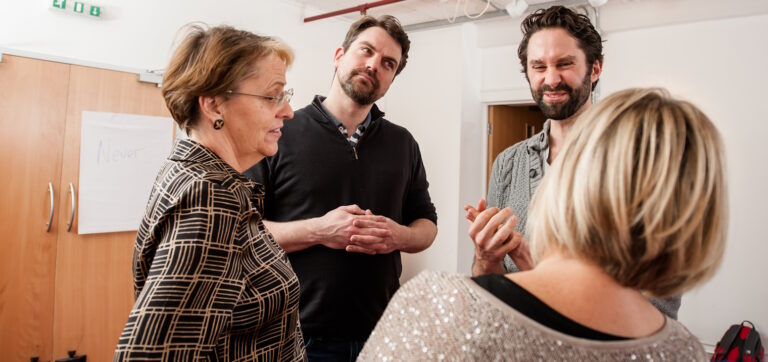
Managing Change in Others
How can we help both ourselves and others deal better with managing change?
It is important to understand how change works if you are a change leader and are managing change in others.
We all talk about “change” – how important it is, how we should alter the way we do things at work and in our personal lives in order to be more effective.
Sometimes we even hear how it is essential to change even if just for change’s sake.
At Impact Factory, we too think that change is important.
However, we are more interested in the process of change and what the implications of change actually are.
The Process Of Change
We exist within a contradiction. On the one hand, we need stability, and we perform well when we feel secure and established in our working and home lives.
On the other hand, we can become stagnant, complacent and uncreative when we shy away from change or when we find we simply cannot cope with it.
How can we bring these two ideas together so that we can rest easier with the apparent contradiction?
And how can we help both ourselves and others deal better with managing change?
Managing Change
Although it seems to have crept up on us, the working environment has changed radically in the past 20 years.
No longer can there be the expectation of a job for life (nor, in many cases, the desire for one).
As organisations become ever more multinational in scope and composition, so people change positions and companies with the rapidity and regularity of football managers moving around the Premiership.
Many companies embrace the idea of change with enthusiasm and fervour, and will even appoint ‘change management agents’ and assign whole departments and programmes to the process of Change Management.
But then they may find that change fatigue makes everything a whole lot slower than they thought it was going to be, which creates frustration and impatience.
They are surprised that even though their fellow employees say they embrace change, huge walls of resistance appear to be erected overnight.
I’m All For Change So Long As It Doesn’t Affect Me
Though people say they are prepared to make changes in their current working environment or decide on more radical change by moving jobs or even careers, it is still part of the contradiction that people also want it to be easy, comfortable and conflict-free.
This is because, as human beings, we all have limiting beliefs, patterns and habits that will get in the way of our being able to incorporate change into our lives when it happens or to initiate change when it is necessary.
We cannot normally predict when change will happen, but we can be better equipped to deal with it when it does. And we can be better equipped to create an environment where change is a natural and exciting ‘organic’ process as well.
Managing Change
That sounds all well and good, but how do we do it?
To begin with, we can look at the limitations we all unconsciously place on ourselves, and how they hold us back from being open to change.
We can start to understand how patterns occur and what we can do to begin altering those that we now see are limiting.
And we can look at the various kinds of changes there are and some effective ways of managing them.
Understanding Change
The greater our own understanding of how we are affected by change and how we react to it, the better prepared we will be to deal with it – whether that change is by our own choice or someone else’s.
Before we look at change management, it is important to mention that it is also true that some people thrive on change.
Some people can’t stay in one job, in one relationship, in one country for very long.
They need to shake up their own status quo.
Sometimes they indeed do create change just for the sake of it. Whether that behaviour is just as limiting as people who find change difficult is a moot point.
So what types of change are there?
Some change is easy; often it is more difficult, and sometimes it can seem downright impossible.
From our point of view there are at least five kinds of changes:
1. Obvious Change
This could be a straightforward change, like changing your car or changing your hairstyle.
2. Good Change
Changing something you already do and relearning it in a new way, like changing your golf swing.
3. Resisted Change
Changing something that obviously needs changing, but you either don’t want to or you can’t quite see how it could be done. This kind of change usually involves a habit – for instance, smoking – You know you shouldn’t, but you can’t seem to stop.
4. Impossible Change
Changing something you absolutely, positively know you can’t change. This kind of change is about beliefs.
5. Imposed Change
Imposed change is something that is done to you, and over which you appear to have no control.
The first three we grapple with every day of our lives. We change in little ways all the time. Perhaps we may struggle a bit with this kind of change. We may never give up smoking, but they are the kind of things we are conscious of. But we can choose relatively easily how we manage this kind of change.
Yes, you may struggle over whether to change your hairstyle or not and you may get some comments for a few days, but it is unlikely that a change in hairstyle is going to fundamentally change your life.
A lot of other things would have to happen alongside that.
And anyone who’s ever tried to change their golf swing will know just how frustrating it can be when you have to go all the way back to basics and re-learn something which has felt a part of you for years.
Again, though, it is unlikely that changing your golf swing is going to fundamentally change your life.
What makes the first three changes similar is that we consciously choose or choose not to make them.
Difficult Change
However difficult they may appear and indeed, may, in fact, be to change, we are absolutely in charge of the decision-making process.
It is the fourth and fifth types of change that can be more difficult and therefore more challenging and confrontational.
Both these types come right up against beliefs that we’ve created that underpin our whole lives.
Why Is Change So Hard Sometimes?
We are pattern-making mechanisms. In general, our systems are more comfortable with patterns and routines than with change.
Once a pattern is established, the left side of our brains (the logical, analytical, pattern-making sphere) will quite happily keep marching along that path.
Because we are physiologically programmed to set patterns very quickly, think about what resistance we have when we try to change patterns of behaviour that have been part of our lives for years.
Some patterns are as simple and straightforward as the order we put our clothes on in the morning or the route we take to work every day.
We can see these patterns and we can see what would be required to change them if we wanted to.
However, some patterns are as complex as the way we feel about ourselves.
For instance, the fourth type of change comes up against patterns we feel are so fundamentally a part of ourselves that we genuinely don’t believe we can change them.
Limiting Beliefs
These are limiting beliefs, which is what the fourth type of change is all about.
This type of change asks us to change a point of view, and adopt a way of seeing the world that is at odds with the way we are used to seeing it.
This experience can easily tap into our insecurity.
We can develop a feeling of unsureness, a sense of not quite knowing what’s the ‘right’ thing to do.
There is no longer a predictable, reliable pattern to follow.
For instance, ever met a new colleague for whom you have an instant dislike?
They remind you of someone you also don’t like and all your beliefs about that type of person will be projected onto the new person.
Evidence Collecting
Your limiting beliefs will tell you that s/he is just like so-and-so, and everything you didn’t like about that original person will feel true about this one
What may then happen, is that you begin to look for traits in their behaviour that will support your belief as ‘proof positive’ that you were right in the first place. That’s how beliefs get reinforced.
What happens if you keep coming up against contradictions in this person’s behaviour that don’t match your beliefs?
You can either keep collecting that evidence (only noticing things when they validate your beliefs) or you can shift your belief.
Boy is that hard to do!
You see, a strong belief feels like the truth and we accept it as such; to ask ourselves to change such a belief can feel like we’re asking ourselves to change the truth.
Limiting beliefs
Restricting or limiting patterns that people have are often to do with low self-esteem. These can be hard patterns to break.
The reason is that a belief system – the pattern – is stronger than the contradictory evidence: it’s been around longer.
If, as you’re growing up, you hear over and over again what’s wrong with you and what you need to do to in order to improve yourself, then you will have a well-entrenched belief system established.
Even when you no longer have your parents, teachers, etc. to reinforce it, the pattern will persist.
Even though these people are no longer the huge influence in your day-to-day life that they once were, you will now speak to yourself with that same punitive, judgemental voice. So even in the face of evidence that you have done a job well, there will be this voice telling you how it could have gone better. After a very short while, the voice will feel as though it’s yours.
Change How You Talk To Yourself
For you to manage to change that voice you first have to become conscious that it’s there. “Oh look, I just told myself off again.” For us, that is a significant victory. You begin to ‘see’ what you do to yourself.
Then you have to do a good deal of what you might call ‘reprogramming’. You have to talk to yourself or with other people about how well you’ve done. You have to create an opposing voice of acknowledgement and praise to counterbalance the punitive voice. And of course, what you don’t want to do is tell yourself off for telling yourself off!
That is why we say that the fourth type of change (changing a belief) can feel extremely difficult or even impossible because our beliefs feel as though they are us. They aren’t; they are just things we believe. In turn, beliefs govern behaviour and expectations.
Now to spice up our change management message, we’re going to say that all beliefs are limiting, even the ones you absolutely know are right and true. As soon as we have a belief about something, it limits our ability to see other beliefs and possibilities clearly. Even if you think you are open to change, tolerant, and judgement-free, eventually something will come along that slams right into one of your well-entrenched beliefs and creates some kind of conflict.
So when your company starts instituting lots of change, and one of those changes is contrary to a well-held belief, natural resistance may suddenly take centre stage.
Imposed Change
The fifth type, imposed change, can often feel like suffering.
If we have no say in the matter we can feel like it is being done to us. We can feel cheated or hoodwinked, and it doesn’t seem fair. Often, even those who instigate it will disown this type of change, putting the onus on something seemingly separate from themselves:
“We have no choice. The market has changed and we must change with it.”
In an ideal world, change management is an ongoing and organic process, and people feel involved in a continuing, evolving way (see Impact Factory’s document, “Culture Change and Open Systems”).
Some companies operate that way; most don’t.
No Choice But Change
Most companies change when they have to. They institute change when their profits are threatened; when they want to streamline; when they upgrade their technology; when they feel the heat of competition; when they want to launch new products or go in a different direction.
Great thought and concern goes into these decisions and they aren’t made willy-nilly. However, to those on the receiving end, it often feels like it’s been done willy-nilly. The ‘powers that be’ may be looking at the big picture but they often miss the smaller snapshots (the individuals affected by the change) along the way.
That’s when the grumbling and discontent and the feelings of being disempowered can arise.
Two things tend to happen, either separately or together.
“It’s not fair, how can they do this?”
“They’re not doing it right, anyway.”
So not only is there dismay that the change is happening, there’s distress that it isn’t the ‘right’ change in the first place. Additional resentment can arise as people criticise new changes:
“I’ve worked in this company X years; I know what works and what doesn’t.”
“Who do they think they are in their ivory tower; I’m here on the ground and I really know what’s going on.”
Our dissatisfaction and helplessness about this type of change comes about because we were never consulted and therefore, never had a chance to buy into it or add our point of view to the process. In order to allay those feeling we often put our energies in the wrong place by gossipping, agitating and resisting like hell because we didn’t choose it.
Strong Feelings
The feelings of anger, anxiety, being hard done by and frustration are real; don’t get us wrong about that. However, if not dealt with appropriately (by you!) then they just get played over and over on an emotional loop that doesn’t really get anyone anywhere.
If you genuinely don’t feel that the imposed change is for the good, then fighting the good fight might be worthwhile. But in our experience, it is anxiety and stress about the process that’s at issue (“How can they do this to us?”), rather than the actual change itself.
The good news, however, is that paradoxically, imposed change can sometimes be a lot easier to manage than we think.
The trick is getting past the
“I don’t want to.”
“It’s not fair.”
“Why me?”
that occurs when something comes along that, in our eyes, messes up the status quo. It’s change we didn’t ask for and didn’t choose. It’s change we may not even think is appropriate.
This is where good counselling skills can come in handy.
The only way through this imposed change is through negotiation with yourself and other people affected by it. Relief from the stress and upset caused by this type of change comes about when people choose to accept and commit to the change, to stop fighting or feeling resentful. If this doesn’t happen then people leave, move away, get divorced, and start sectarian underground movements.
Acceptance
Accepting and committing to change also doesn’t mean capitulation. It means contributing, cooperating, adding a new voice and possibly even managing the change by becoming a ‘change facilitator’.
Why we say there’s good news is because in our experience, once people get over their initial anxieties and fears about change, they can be excellent ambassadors and advocates. What needs to happen is that they feel they have some choice in the matter.
Imposed change, however, looks as though they don’t have a choice: like it or lump it.
Not true. The initial change may have been imposed, but if you are able, help people find one thing in the new ways of doing things that they agree with and approve of, let them concentrate on that. Then they don’t have to buy into the whole package (which, of course, is what companies want – happy people who’ll go along with whatever is being done this time), but they can be guardians for the bits they think will work.
Managing Change in Others – Encourage them to Choose
The more you can encourage others to choose (even if only a portion of the whole programme), the more they will feel empowered. If you try to ‘make’ people accept everything as good, they will resist. You need to allow them to choose areas where they feel able so that they can feel more confident.
One of the major reasons people resist change is because they don’t think they will be able to do it. They’ve been working just fine, thank you. They know where they stand, they know what’s expected of them, and they have their routines and ways of working. With change, people often come up against their limiting beliefs to do with their abilities, and their confidence is undermined.
This, in turn, can lead to a fear of being humiliated; of not coming up with the goods just when they are most required. And people will do just about anything to avoid humiliation. A bit of reassurance that you know they’re up to the job, or will get support to ensure they’re up to the job, will go a long, long way to managing anxieties and easing the fear of humiliation.
Giving people things they know they can handle builds confidence and encourages buy-in. Managing change is also a lot easier than trying to get them to change their attitudes wholesale.
Role Modelling Change
Your ability to manage someone else’s change is apparent when you manage your own change and make it visible within your organisation. Too often we have seen change management programmes where those in charge act as though everything is completely under control and running smoothly.
This doesn’t help anyone. No one handles change with complete ease and free from struggle. Yet that type of behaviour is what is often ‘displayed’. This makes it doubly hard for others to handle, for not only are they tasked with incorporating change, but they also have role models who act as though it’s a piece of cake.
We’ve seen wonderful, well-thought-through change management programmes that are – voila! – unveiled after months of agonising, decision-making, going back to the drawing board, redesigning. But no one knew about them until they were sprung, fully formed, on the general corporate populace. What we’ve then seen happen is that people got upset and angry and began criticising the change as a way of expressing their resentment.
Truly being an ‘agent for change’ means displaying your own vulnerabilities, struggle and difficulties, and yes, even failures. It means sharing information and making public the process you and others have been and are going through.
Lead By Example
When we talk about leading by example, it doesn’t mean you have to be invincible, invulnerable, perfect and doing it right. Along with your enthusiasm and commitment to making important changes around you, it means you have to let others know your own doubts and concerns, and it means asking for support and being seen to ask for support. It could even mean letting others see your weak spots and where you have difficulty coping.
We don’t mean you have to go around like a gibbering wreck! Far from it; but letting others see that you are indeed human, will allow them to be human too; and you’re far more likely to get buy-in and commitment if you do.
Here’s an example:
We were brought into a company to help them restructure and redefine the way their Customer Service department worked. They wanted people to be more effective (who doesn’t!), accomplish more and enjoy their work better. One of the things we noticed was that no one ever took lunch. If they did it was a sandwich and a packet of crisps at their desks. The belief (limiting) was that they were getting more done by not taking a lunch hour and working through.
We told the senior managers that they had to start going out to lunch. We said ‘money-back guarantee’ that if they went out to lunch, their staff would follow suit and work output would go up. This was one of the smallest changes we could identify that we believed would make a significant impact.
And it did.
But it took the senior managers showing their staff that not only did they get hungry but that it really helped them to leave the building and get a change of scenery. It sounds so simple and obvious but we are continually surprised how the simple and obvious get overlooked.
No one is superhuman, however much they want to give that impression.
Managing Your Change And Others
Alongside modelling change goes managing other people’s change. Like so much else in life most of us tend to think that other people can do what we do. We know on one level that that’s not possible, but we still act as though it is.
When you manage or facilitate other people’s change you have to accept that everybody’s capacity is different, and everybody’s ability to change is different.
We’ll look at you first.
When was the last relatively major change you had to deal with personally or at work? Using our list of types of change, which type was it? How did you do? Was it easy, hard, difficult, or impossible? What feelings did it create in you? Did you have coping mechanisms that you used?
What is the biggest change you think you could take in your stride? Losing your hair? Having your car stolen? Losing your job? Or losing your partner? Promotion? Relocation? Winning the lottery? Becoming a parent? Moving house?
When you think about the biggest change you could take in your stride, think also about someone you know who, given the same situation, would feel stressed, anxious and unable to cope. They won’t react the same way as you do.
Now try working out what additional change you could manage at the same time. At what point do you know you’ve reached your limit? In our experience, most people know they’ve reached their limit only when they’ve surpassed it.
We all have a limited amount of new that we can cope with at any one time.
So when you are charged with managing or facilitating change for others, you need to have a pretty clear idea of each individual’s capacity for change and each person’s limits.
So What Else Can You Do?
Change is inevitable; and for the most part, it is for the good. No one lives a life free of change, but sometimes we are visited by more change or demands for change than we can cope with.
When this happens it helps to manage what’s is going to get your attention and effort. Too often, as we mentioned, people put their energy and effort in the wrong place (or, if not the wrong place, too many places at once) because they feel stuck or disgruntled and need to feel as though they are doing something.
Since any change is hard work, invest wisely. Find a small change that will have a large effect. Develop something you like to do as opposed to a chore. That way there’s a chance you’ll work on it rather than worry about it. Be wary of wholesale change and change for change’s sake, both of which will add considerably to your stress. A lot of the work we do at Impact Factory consists of simply stopping people from putting effort into inappropriate projects.
Aim low at first. Pick things to change that you know you’ll succeed at. For example a few years ago, in an effort to raise the general level of fitness in the country the Government set the fitness criteria at 20 minutes of vigorous exercise three times a week. Gyms filled with people determined to change their bodies and get healthy. After a while, the gyms emptied out (though memberships were kept up so people could have the illusion of getting fit!) and people now had something new to feel guilty about.
What has happened since is that the government realised that they set their targets too high. Now the idea of a good base level exercise standard is to walk the dog or simply walk to the shops instead of driving. A lot more people are likely to be able to do that and it doesn’t take much to be a success at this type of exercise programme.
Minimise The Struggle
Change is a whole lot easier to take on board when there’s minimal struggle. If someone within a company is presented with changes that feel as though a massive effort is required, the likelihood is that they will resist. However, if a change management programme can be broken down into bite-sized chunks that feel doable and relatively easy, there is a greater likelihood that you’ll get a degree of co-operation.
Create an environment where some form of managed change is the norm. There’s a wonderful story about the film director Ridley Scott whose son talks about being hauled out of bed at the crack of dawn to help his father move the furniture in their house. By changing the furniture around, the environment changed, even if only slightly; and in turn, how the family related and worked in the environment had to change.
They didn’t do wholesale buying of new furniture, they simply shifted what was already there. Impact Factory took to this idea with delight, and you will find that every six months or so, we move the furniture. That could look like literally moving the furniture; or it could be getting new plants, rewriting our training materials, upgrading our computers, and cleaning out cupboards. We aren’t creating change for change’s sake; we are stimulating our environment so that routine doesn’t make us stale.
What we like about this kind of change is that it’s easy, it’s minimally disruptive and yet it does force people to think differently.
Change In Your Personal Life
You can do this at home! Move your sock drawer. Or move your wastepaper bin to the other side of the desk. You won’t be able to do routine. Every time you go for a fresh pair of socks (for about 2 to 3 weeks after which a new pattern sets in) you won’t find them where you expect to. You will have to do something different, however small.
If you deliberately do enough small changes on a regular basis, when the big ones come along, you, and others, will be far more prepared to manage (and manage well) not just with the changes themselves, but the idea that change is a good and healthy thing to do.
Here are a couple more ways to practise change. Change your mind. For no reason whatsoever. So often people are embarrassed to change their minds; it’s as though once you’ve made it up your mind can’t budge. So try this: next time you go to a restaurant place your order and a minute later change your mind and order something else.
Walk around the supermarket the opposite way you’re used to. You may find that you don’t automatically buy the same things because they won’t be in the order you’re used to.
Find something you do that you want to stop doing. The ‘normal’ way we approach something like this is to create a ‘stopping’ plan, which usually requires deprivation of some kind or at the least doing something radically different. Instead, try overdoing it, rather than trying to stop. Do more of it, not less.
This way of doing things challenges a belief that most people have: if you have a ‘bad’ habit, you must stop it. It’s that punitive, critical voice again. Overdoing it helps break the “I shouldn’t” “It’s wrong” “I must stop” pattern of thinking and feeling.
This is what we mean by creating an environment where change is the norm. You’re making little tweaks and adjustments to your everyday patterns and habits, not getting a new life.
Change In Your Working Life
The same is true for your working life.
As well as moving the furniture, you can help yourself and others adapt more positively to change by incorporating new ways of working that don’t have to be radical, even if some of the new changes are.
For instance, we know that when companies launch change management programmes they want everyone to be positive and see all the good reasons for it. They think that criticism and negativity are wrong and will undermine the change management process.
We think differently. Allow other people to have their concerns, anxieties, negativity and cynicism.
When people argue about the changes, telling you why they won’t work, try not to defend, justify or persuade why you’re right and they’re wrong. See if you can avoid trying to ‘convert’ them. Instead, find something in their argument to agree with.
You don’t even have to agree with their basic objections, but most counter-arguments have some validity; so look to validate without giving up your position. For instance:
In the face of:
“It’s not going to work; I’ve seen this all before, and it didn’t work last time,”
what people then tend to do to counteract the negativity is to launch into a whole list of reasons why it is going to work this time, effectively cutting down the other person and ignoring what they’ve said.
You Could Try This Instead:
“You’re right, it didn’t work last time.”
And then pause and keep silent for a moment. Leave ‘space’ for the other person to say something, often it will be:
“So what makes you think it will work this time?”
if they don’t, you can carry on:
“We know it didn’t work last time, so we really hope we’re on the right track this time. And any ideas you have would be great.”
Indeed, encourage other people’s ideas and suggestions. When people tell you why something won’t work, rather than dismissing it, see if you can shift the negativity by exploring why they think it won’t work and what they think would. You’d be surprised at how close people will come to what you wanted doing in the first place.
Feeling Consulted
When you don’t dismiss people’s negativity and give them a chance to air their thoughts, they will feel heard and be far more likely to want to offer something back, than if you reject what they’re saying out of hand. If they feel consulted even after the fact, they have an opportunity to opt in, to choose to be involved.
As we mentioned earlier, communicate your own efforts, both positive and negative. Let others know of your concerns and commitment. Demonstrate your enthusiasm without trying to convert other people.
Meet regularly with colleagues at all levels. Too often, when a change management programme is initiated, people say they’re far too busy to meet. Don’t accept that – simply make the meetings shorter. Think about having breakfast meetings or lunch brainstorms or teatime airing sessions.
Look for things that could be fun to do. We’ve already said that if it’s hard work, people won’t do it; they’ll just go through the motions and pay lip service. As soon as the pressure mounts or they take their eyes off the ball, the same old patterns will recur.
Finally, don’t do it alone! Enrol others in your change management plans. Just talking about something develops support for it. Get a buddy or a coach. Everyone needs support and demonstrating your own need for it, and how you work with it, can be one of the most inspiring examples of managing change that you can give to other people.
This is as true in your personal life as it is in your working life.
Managing Change in Others
Impact Factory runs
Open Change Management Courses
Tailored Change Management Training
Five-Day Communicate With Impact Workshops
and personalised
One-to-One Managing Change Skills Training
for anyone who is interested in
Change Management Issues





